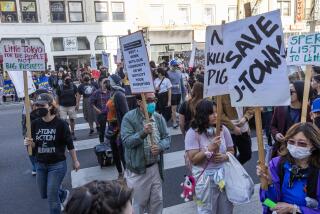How to roast coffee in the Japanese style
On a recent afternoon in the courtyard of Tortoise General Store on Abbot Kinney, Arata Doyashiki of the newly launched DCR coffee company stands over a Kalita dripper and carefully pours hot water out of a Takahiro kettle onto beans she’s roasted herself. In the traditional Japanese coffee brewing style, she pours water slowly and steadily into the center of the ground coffee beans, watching the small brown bubbles rise to the top of the filter.
On Aug. 23, Doyashiki will have her kettle at the ready in the Tortoise General Store courtyard from 1 to 5 p.m. Sept. 27 will be the last day in this series of pop-ups at Tortoise that began in March with Shiho Yoshikawa from Sweet Rose Creamery. Although this will be the last day of their monthly pop-ups, Doyashiki and Yoshikawa plan to team for more events soon.
------------
FOR THE RECORD
Aug. 4, 12:39 p.m.: An earlier version of this article said DCR’s next pop-up will be Sept. 27. It will be Aug. 23. And the last pop-up at Tortoise will be on Sept. 27, not Sept. 23.
------------
Future plans for DCR include a café that serves pour-over coffees at the table and French pastries.
For Doyashiki the process for making a pour-over has a very specific technique. “In the Japanese style you focus on pouring the water in the center,” she says. “You keep the bubbles on the surface. You don’t let it go down and mix in.” Doyashiki feels this is the best method for letting the carbon dioxide escape, then not mixing it back down into the coffee beans, the way some other methods involve swirling the water around or stirring the ground coffee.
When it came time to open her own business, Doyashiki found a used 12-kilo Diedrich roaster — in Athens, Ga., and brought it to a space she’d found in Northridge.
With green coffee from Royal, she’s currently roasting Guatemala RFA Antigua, Colombia Llano Redondo and a special blend for Tortoise General Store. Japanese roast is generally darker than typical American roast. “Flavor-wise, Japanese people prefer rich, mellow, round but clean coffee.”
Doyashiki remembers a day when she needed a Kalita dripper and had no luck at a Japanese market. Next stop was Tortoise, where they not only had the one she was looking for in stock, but she also met fellow coffee enthusiast, Tortoise store manager Herbert Johnson. Then she mentioned she was a coffee roaster and offered to do an in-store tasting.
The first time Doyashiki brewed coffee for Johnson, she used a Japanese coffee-shop-style flannel cloth filter. Johnson, who regularly travels to Japan and visits coffee shops, was happy to find someone in Los Angeles with whom to share knowledge about Japanese coffee traditions and preferences.
Doyashiki grew up in Tokyo, where a roaster occupied an honored place in her family’s patio. Once her father had completed the roasting process, her mother was in charge of brewing. They made coffee twice a day as part of in a cherished ritual.
“I tell people I have been caffeinated since 2,” Doyashiki says. “When I would come home from school in kindergarten, from blocks away I could smell if my father was roasting coffee.” As soon as she was old enough to be close the fire, she was trusted to turn the manual crank.
Her parents had owned a coffee shop in Tokyo before she was born — and though they closed the shop, they kept the roaster going.
Doyashiki thinks that the time she spent working with a manual coffee roaster helped her learn to understand roasting on a sensory level. “I hear it. Smell it. See it. And with a hand roaster you feel the weight of the beans change. You are holding it and turning it for 25 minutes. You get a lot of direct sensory information from the beans.
“The traditional Japanese style pour-over style is not really seen anymore. I’d like to have more chances to show it to people here.
Tortoise General Store, 1208 Abbot Kinney Blvd., Venice, (310) 314-8448, tortoisegeneralstore.com.
More to Read
Eat your way across L.A.
Get our weekly Tasting Notes newsletter for reviews, news and more.
You may occasionally receive promotional content from the Los Angeles Times.






